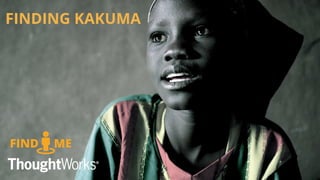Finding Kakuma - Mike Gatman, Thoughtworks
- 2. Kakuma refugee camp, NW Kenya Established in 1991 Over 193,000 refugees 53% are from South Sudan, mainly Nuer 12,700 South Sudanese children are registered as unaccompanied (UNHCR)
- 4. DISCOVERY
- 5. To help refugees in Kakuma find missing relatives through a web application which refugees are both involved in designing and, by its design, are given choice and self-determinism
- 6. PRINCIPLES OF THE FIND ME APP CHILD SAFETY IS PARAMOUNT COMMUNITY-LED, COMMUNITY-DRIVEN KEEP IT SIMPLE ŌŚÅ Minimise human interaction ŌŚÅ Only store necessary data ŌŚÅ Secure data storage ŌŚÅ Concept originated in the community ŌŚÅ Community to facilitate in data entry ŌŚÅ Idea will spread through word of mouth and through community establishments ŌŚÅ Limited data capture validation ŌŚÅ Engaging, simple user interface ŌŚÅ Technology and services in line with Kakuma capabilities
- 7. DISCOVERY INSIGHTS Low level of literacy and technical ability for South Sudanese refugees Refugees are usually familiar with SMS based services, such as M-Pesa Unaccompanied children often arrive in a guardianship arrangement Smartphone usage is growing in the camp; everyone knows someone with a smartphone Facebook and WhatsApp are popular amongst smartphone users Given the prevalence of unaccompanied children from South Sudan, the primary focus would be the population of South Sudanese refugees
- 8. PERSONAS
- 9. CHUOL 8 year old Nuer boy from South Sudan who lives in Kakuma with a guardian His goal is to let his mother know where he is Low English literacy and technical ability Very playful His guardian could decide that she can no longer care for him, making him vulnerable to gangs
- 10. BENCEE 20 year old South Sudanese teacher who can act as a facilitator, speaks Nuer, English and Swahili Lived in Kakuma for 3 years, good level of literacy and smartphone awareness Gained credibility within Nuer community in Kakuma, has a goal to help others May wish to leave Kakuma, or could lose interest in the facilitator role due to conflicting priorities
- 13. USER TESTING
- 14. Confirmed that Somalis and Ethiopians are sufficiently tech savvy to understand Find Me Nearly all South Sudanese struggled with navigational patterns and the wording of questions, and would need a facilitator Iterative updates to the flow and questions, with Lieven retesting each new version UI was adapted to the point it was understood by smartphone aware refugees
- 16. SECOND ITERATION
- 22. LESSONS
- 23. Establishing a cultureŌĆÖs relationship with technology is essential - be prepared to trial a number of ideas Stopping is not necessarily failure: think alternative success models Any example of: ŌŚÅ A changed practice ŌŚÅ New business model ŌŚÅ Or new technology can be disruptive in the humanitarian space but must be facilitated by a shared write up Insights into technology, UX and typical organisational challenges allow the discovery of new partnership opportunities
- 24. THANK YOU
























